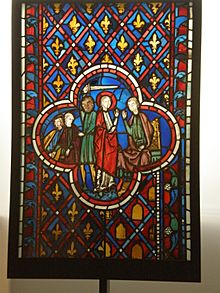Daniel (biblical figure) facts for kids
Quick facts for kids Daniel |
|
|---|---|
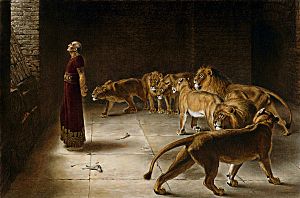
Daniel's Answer to the King by Briton Rivière
|
|
| Prophet (Christianity, Islam) | |
| Venerated in | |
| Major shrine | Tomb of Daniel, Susa, Iran |
| Feast | July 21: Roman Catholicism December 17: Greek Orthodoxy Tuesday after fourth Sunday of Pentecost: Armenian Apostolic Church |
| Attributes | Often depicted in the den of the lions |
|
Tradition or genre
|
6th century BCE |
Daniel is a famous figure from the Hebrew Bible. His name means "God is my Judge." He is the main character in the Book of Daniel. The Bible tells us that Daniel was a young Jewish noble from Jerusalem. He was taken captive by King Nebuchadnezzar II of Babylon.
Daniel served the king and his successors with great loyalty and skill. He stayed true to his God even while living in a foreign land. Some scholars believe Daniel was a real person from the 6th century BCE. However, most scholars think the Book of Daniel is a story written later, around the 2nd century BCE. It uses Daniel's story to talk about events from that time.
Today, several cities claim to have Daniel's tomb. The most famous one is in Susa, Iran. Daniel is seen as a prophet in Christianity and Islam. In Judaism, he is not called a prophet, but he is highly respected for his wisdom and good deeds.
Contents
Who Was Daniel?
Daniel's name, "God is my judge," fits his story well. He is best known for interpreting dreams and having special visions. The Bible also mentions a few other people named Daniel:
- The Book of Ezekiel talks about a legendary Daniel. He was known for being very wise and fair. The author of the Book of Daniel likely used this famous figure as the hero for his own story.
- The Book of Ezra mentions a priest named Daniel. He traveled from Babylon to Jerusalem with Ezra.
- The First Book of Chronicles lists a son of David named Daniel.
There was also an ancient figure named Daniel (or Dn'il) in stories from Ugarit. This city was destroyed around 1200 BCE. This older Daniel was also known for his wisdom and fairness. He followed a god named El, which is part of his name. It's possible there's a connection between these different figures named Daniel.
Daniel's Adventures in Babylon
The Book of Daniel starts by explaining how Daniel and his friends ended up in Babylon. It then tells exciting stories about them in the courts of the Babylonian and Persian kings. The book also includes visions Daniel had about the future.
When Daniel and his friends Hananiah, Mishael, and Azariah arrived in Babylon, they were chosen for their intelligence. They were trained for the king's court and given new names. Daniel was called Belteshazzar. His friends were called Shadrach, Meshach, and Abednego. Daniel and his friends refused to eat the king's rich food and wine. They wanted to stay true to their faith. God gave them special wisdom, and they became smarter than all the king's wise men.
King Nebuchadnezzar had a strange dream about a giant statue made of different metals. Only Daniel could explain it. He told the king that the dream meant four kingdoms would rise and fall. But in the end, God would create His own kingdom that would last forever.
Later, King Nebuchadnezzar dreamed of a huge tree that covered the whole world. A heavenly figure said the tree would be cut down. Again, only Daniel could explain the dream. It was about God's power over all earthly kings.
When Nebuchadnezzar's son, King Belshazzar, used holy cups from the Jewish temple for a party, a mysterious hand appeared. It wrote a message on the wall. Only Daniel could read it. He told the king that his kingdom would be taken over by the Medes and Persians. This was because Belshazzar had not respected God. Soon after, the Medes and Persians conquered Babylon.
The new king, Darius the Mede, gave Daniel a high position. Other officials became jealous. They tricked the king into making a law that no one could pray to any god except the king. Daniel kept praying to his God. Because of this, he was thrown into a den of lions. But an angel saved him! His enemies were then punished, and Daniel got his important job back.
Daniel also had visions about the future. He saw different kingdoms rising and falling. He learned about a time when God's people would suffer. But he was told that in the end, good would win, and God's kingdom would be established on Earth.
More Stories About Daniel
The Greek version of the Book of Daniel includes two more stories about him:
- The story of Susanna is about a young Jewish woman. Two older men falsely accused her of something bad. Daniel cleverly questioned them and showed they were lying. This saved Susanna's life and reputation.
- The story of Bel and the Dragon has two parts. First, Daniel showed that the priests of a false god were tricking people. They pretended their idol ate food, but the priests were secretly eating it themselves! Second, Daniel destroyed a giant snake that King Cyrus believed was a god. The people of Babylon got angry and put Daniel in prison without food. But a prophet named Habakkuk miraculously brought him food. After this, King Cyrus realized his mistake.
Where is Daniel Buried?
The Book of Daniel last mentions him during the rule of King Cyrus. Some Jewish writings say he was still alive later but was killed by a wicked prime minister named Haman.
Ancient writers said Daniel's body was in a tower in Parthia. Later, Jewish leaders said he was buried in Susa. They also said that holy items from the Temple of Solomon were hidden near his house.
Today, six cities claim to have Daniel's tomb. The most famous one is in Susa, Iran, at a place called Shush-e Daniyal. According to Jewish tradition, people in the city argued over who should have Daniel's body. So, his coffin was hung by a chain over the middle of a river. A place of prayer was built nearby for everyone who believed in God. Fishing was not allowed in that part of the river. It was said that fish there had golden heads! People who were not good would mysteriously drown in the river if they entered the sacred area. Even today, this tomb is a popular place for people to visit and pray.
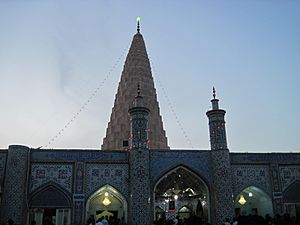
Daniel's Influence Through Time
Daniel's story has been important to many people and religions for centuries.
Daniel in Judaism
In Judaism, Daniel is not considered one of the traditional prophets. This is because prophecy was believed to have ended with other figures like Haggai. However, Daniel's book was very popular in ancient times. Many copies of it were found among the Dead Sea Scrolls.
Jewish rabbis (teachers) from long ago saw Daniel as the most respected Jewish person living in Babylon. They admired his strong faith and good deeds. He stuck to God's laws even when surrounded by enemies. Over the centuries, many stories grew around his name.
For example, it's said that Daniel always cared about King Nebuchadnezzar. When God punished the king to live like an animal for a time, Daniel prayed for the punishment to be shorter, and his prayer was answered. It's also said that Daniel refused to be an heir to Nebuchadnezzar's throne. He also helped King Darius regain his sight after the king wrongly imprisoned Daniel. Many people then converted to Judaism because of Daniel's actions.
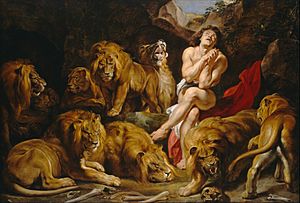
Daniel in Christianity
The New Testament mentions Daniel in the Gospel of Matthew. Christians remember Daniel on different feast days. For example, the Eastern Orthodox Church celebrates him on December 17. They often connect him with the "Three Young Men" (Shadrach, Meshach, and Abednego).
In Orthodox hymns, Daniel's prophecy about a stone smashing an idol is used as a symbol. The "stone cut out without hands" represents Jesus. The fact that it was "without hands" symbolizes the virgin birth of Jesus. So, the Theotokos (Virgin Mary) is sometimes called the "uncut mountain."
The Roman Catholic Church remembers Saint Daniel on July 21. Some local churches might celebrate him on other days.

Daniel in Islam
Daniel (Dānyāl in Arabic) is not directly named in the Qur'an. However, later Muslim writings describe him as a prophet. These stories tell how he was saved from lions. They also mention him interpreting the king's dream about a statue and the writing on the wall. All Islamic sources, both old and new, describe Daniel as a holy and righteous person.
A famous Qur'an scholar, Abdullah Yusuf Ali, wrote that Daniel was a noble and righteous man. He lived around 620–538 BCE. He was taken to Babylon but still held important jobs there. He always stayed true to Jerusalem. Even when a law was passed against praying to anyone but the Persian King, Daniel continued to pray towards Jerusalem three times a day.
Shiʾa Hadith (sayings and traditions) also confirm Daniel as a prophet of God. They agree with the events described in the Bible about Daniel.
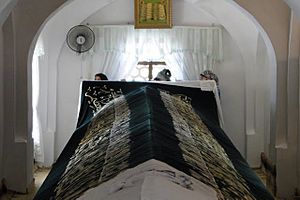
Daniel in the Baháʼí Faith
In the Baháʼí Faith, Daniel is considered a minor prophet. Some Baháʼí followers have even discussed the idea of Daniel's spirit being reborn in other figures.
See also
 In Spanish: Daniel (personaje bíblico) para niños
In Spanish: Daniel (personaje bíblico) para niños
- Apocalypse of Daniel
- Arioch, Captain of the guard
- List of names referring to El
- Persian Jews


